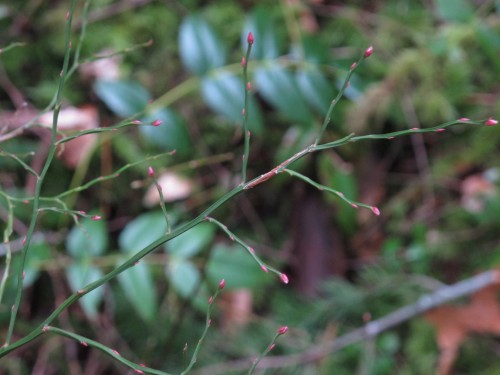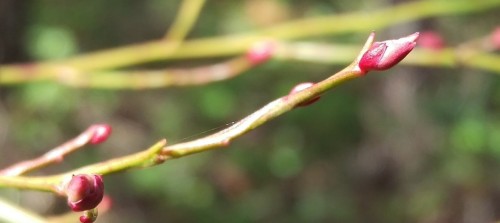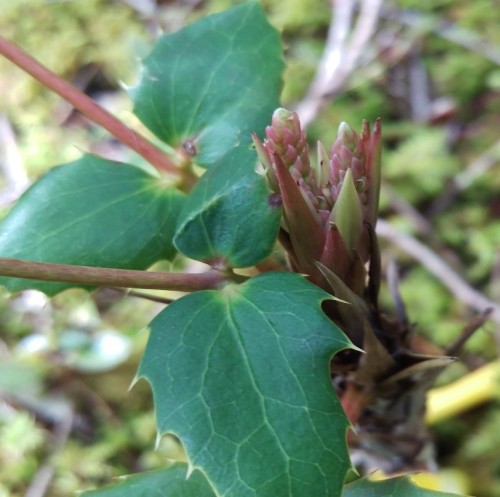A Phenology Fix

By Sasha Savoian, part of the Institute’s 15th Graduate Cohort.
The shifting of seasons. Temperature begins to rise as the arch of the sun lifts. Winds push and pull pendulous crowns of Hemlock and Western Red Cedar while gusts careen through limbs of Doug fir. Rains drench the lichen and moss covered landscape. Sun surprises. Days overshadow night. Subtle, sweet scents of spring waft unexpectedly in a warm breeze. Buds begin to break. Robins appear overnight.

A Red Huckleberry limb with breaking buds along the Diablo Lake trail at the Environmental Learning Center.
The shifting of seasons. Spring is recently arrived, but the harbingers have slowly appeared up here in the North Cascades at 1,200 feet: buds of Willow, Red Flowering Currant and Indian Plum awaken, the catkins of Hazel and Alder open and dangle in preparation of pollen release, Varied Thrush, Robins and Pacific wrens sing the morning alive, a frog note travels through the air at dusk. At least a few of us up at the Environmental Learning Center on Diablo Lake are tuned to the frequency of phenology as we have eagerly awaited the firsts to unfurl. Phenology is essentially the study of seasonal cycles in the natural world, paying particular attention to the connectivity of the species within an ecosystem. Phenology encompasses events such as bird migration, phases of buds on trees and shrubs, hibernation and the hatching of insects related to changes in temperature, amount of sunlight and precipitation associated with shifts of seasons.
Aside from my own personal fascination with the alchemy of phenology, why should other people care? Clues to the health of an ecosystem and to our planet can be found in the patterns of seasonal blooms and migrations. For example, what are the implications of an early arrival of spring? As humans, indicators of spring occurring 2-3 weeks early may or may not affect our lives. But to an avian friend who journeys hundreds, if not thousands of migration miles, it will matter if specific flowers have bloomed and insects have hatched early. Birds could arrive too late to feed on critical proteins needed for mating and nest building because spring unfolds earlier than the previous year. By studying phenology, we can track the progression of seasons and who is doing what and when in the environment as well as identifying altering trends attributed to a changing climate.
North Cascade Institute staff and graduate students participate in citizen science by recording phenological data at four designated sites around the Learning Center and we report our results to Nature’s Notebook, a project with USA National Phenology Network. Citizen science allows any person to record observations around her home ecosystem to help scientists and researchers gather data and detect patterns that can tell a more accurate story of a landscape. This availability and quantity of information paints a big picture of what cycles are changing and how all across the country. An added benefit of citizen science involves getting people outside exploring and making observations about trees, plants, flowers, insects and birds on a weekly basis.

An Oregon Grape sprouts flower buds in March on Diablo West trail at the Environmental Learning Center.
Yellow flags mark the individual plants to be studied at four different locations in the coniferous and deciduous forests surrounding the Learning Center. We have been keeping a watchful eye lately to detect subtle changes in bud shape and form. The Nature’s Notebook website prompts us for each plant we are studying by asking if new buds are appearing, whether the buds are breaking, whether leaves are forming and how many, whether flowers appear and on into the autumnal phases like the appearance of berries, the changing colors of leaves and finally how many leaves have fallen. While noting these specific questions, we also make note of birdsong we hear, insects we spy crawling or flitting about, lichen and moss that appear, tracks, scat or other sign of mammal activity, and most anything we deem interesting that occurs in the area. These areas are on the second year of scrutiny so patterns are still being discerned, but by intensely studying the pheno phases and subsequent birdsong, we are beginning to understand this place more deeply. We are beginning to feel the rhythm and pulse of this incredibly diverse ecosystem at 1200 feet at the base of Sourdough Mountain; an area sliced by streams, bounded by the mineral studded waters of Diablo Lake, an area that receives 80+ inches of rain a year, an area held together by Western Red Cedar, Alder, Hemlock, Cottonwood, Doug Fir and Pacific Silver Fir trees that we are growing more attachment to daily.
And finally the sun, when it finally decides to break loose from the clouds, crests Pyramid Peak again while rays shoot though the towering trees onto the Salal and Oregon Grape covered floor and giving the life force to plants that push the buds further out on the limb. Finally, spring has come around the bend again as Robins, Varied Thrushes, Downy Woodpeckers and Dark Eyed Juncos return from their winter homes. The Oregon Grape stalks are sprouting, Red Alder trees are releasing pollen by opening their catkins, the Red Flowering Currants have dropped their flower that will soon bloom and the hummingbirds will be soon to follow. It’s spring and I and others are frantically taking phenological notes to press pause on the explosion of new growth that will be abundant when the sun shines in the absence of clouds and the temperature breaks 60 degrees for a few days.
It’s important to stop and take note of what is happening around us, the connections between weather and its affect on the earth. Perhaps the sweet smell of a lilac bush, a little mud on the boots and learning a new birdsong will begin to loosen and expand views of the natural world to allow compassion to seep in through the cracks. Partaking in the study of phenology can root us just a little deeper in an understanding of the intricate systems within a particular landscape.

